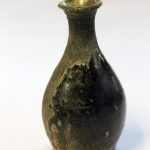“. . . and those nameless craftsmen created these marvelous chawan (tea bowls).” Thus do clueless authors drone on in pottery tome after pottery tome. The potters in question, given the chance, would surely take exception to the authors’ arrogant assumptions about their anonymity. Their plight calls to mind that of the Native Americans, surely incredulous at the Europeans’ boast of having “discovered” the Americas.
“Nameless,” here, means little more than the authors’ ignorance of the potters’ names. The potters’ friends and family members surely knew and called them by their names. Their patrons presumably did likewise. We can assume confidently that no one addressed any of the potters as “Hey, nameless” or “Good morning, Anonymous” or “Nice work, Unknown!” Yet the notion of anonymity is a central theme in the fanciful interpretations woven by generations of pottery commentators.
The pottery commentator most influential in nurturing the romantic notion of anonymity was Yanagi Soetsu (1889–1961). Yanagi positioned that notion as a central precept of the Mingei (folk craft) movement. He propagated the Mingei movement through his writings and through his personal interaction with such potters as Shoji Hamada (1894-1978), Kawai Kanjiro (1890-1966), and Bernard Leach (1887-1979). The Mingei potters, meanwhile, frequently honored the principle of anonymity by refraining from marking their pottery with their studio imprints.
Yanagi evoked his fixation with anonymity in the title of an English-language compilation of his Mingei philosophy, The Unknown Craftsman. He published that work with the assistance of Leach, and it has become an enduring source of inspiration for readers amenable to romanticizing history’s neglect of potters’ names.
We can learn a lot about the widespread preoccupation with names by observing people’s behavior at museum exhibitions. Note how some visitors read the label of each painting, pottery object, or whatever before casting their eyes on the work itself. Some, of course, inspect the work first and then check the label. And some make their way through the entire exhibition without once turning their eyes to a label.
The labels, we suspect, become a sort of filter for museumgoers who read them before looking at the works. Viewers presumably are more receptive to works by artists whose names they recognize than to works by unfamiliar (to them) artists. Yanagi and his Mingei kindred spirits, in romanticizing anonymity, put a new twist on the game of names.
Let us note that Yanagi’s romanticizing of the “unknown craftsman” included a large dollop of condescension, especially in Korea. Yanagi traveled repeatedly to Japanese-occupied Korea. He worked tirelessly and, in view of the political climate, courageously to call attention to the aesthetic value of traditional Korean ceramics. But his writings betray a patronizing stance. He calls on the Koreans, for instance, to endure stoically the suffering incurred by the Japanese occupation.
Yanagi and other commentators who dwell on what they choose to regard as the unknown, nameless anonymity of potters commonly reveal another preoccupation. They somehow identify in works by the “unknown craftsmen” evidence of “artistic detachment.” And they laud that detachment, or “unconscious artifice,” as a supreme virtue.
Detachment ranks as a virtue in several strains of Buddhist teachings and is a particular emphasis in the realm of zen. Yanagi absorbed tremendous influence during his life from D. T. Suzuki (1870–1966), famous for introducing zen to the West, and he incorporated what he regarded as a Buddhist aesthetic in his Mingei philosophy.
Yanagi’s formal Buddhist affiliation was with the Jodo Shinshu school, which preaches a Christian-like reliance on a higher power. Suzuki, for his part, valued the “wet” emotiveness of Jodo Shinshu as an indispensable counterbalance to the “dry” intellectualism of zen. The two forged a dynamically complementary relationship, and Suzuki delivered a famously tearful eulogy at Yanagi’s funeral.
“Detachment” and “unconscious artifice” were natural expressions of Yanagi’s Buddhist aesthetic. Yet how in the world he or anyone could detect such qualities in a piece of pottery remains a mystery. For that matter, how in the world a potter could craft a work from a “detached” posture or “unconsciously” is equally unfathomable.
Quality pottery is, at the end of the day, the product of conscious work by fully engaged (undetached) potters. Let us hope that sincere aficionados will assess pottery on the basis of viewing the actual work honestly rather than succumbing to unfounded notions of detachment or of unconscious artifice.






